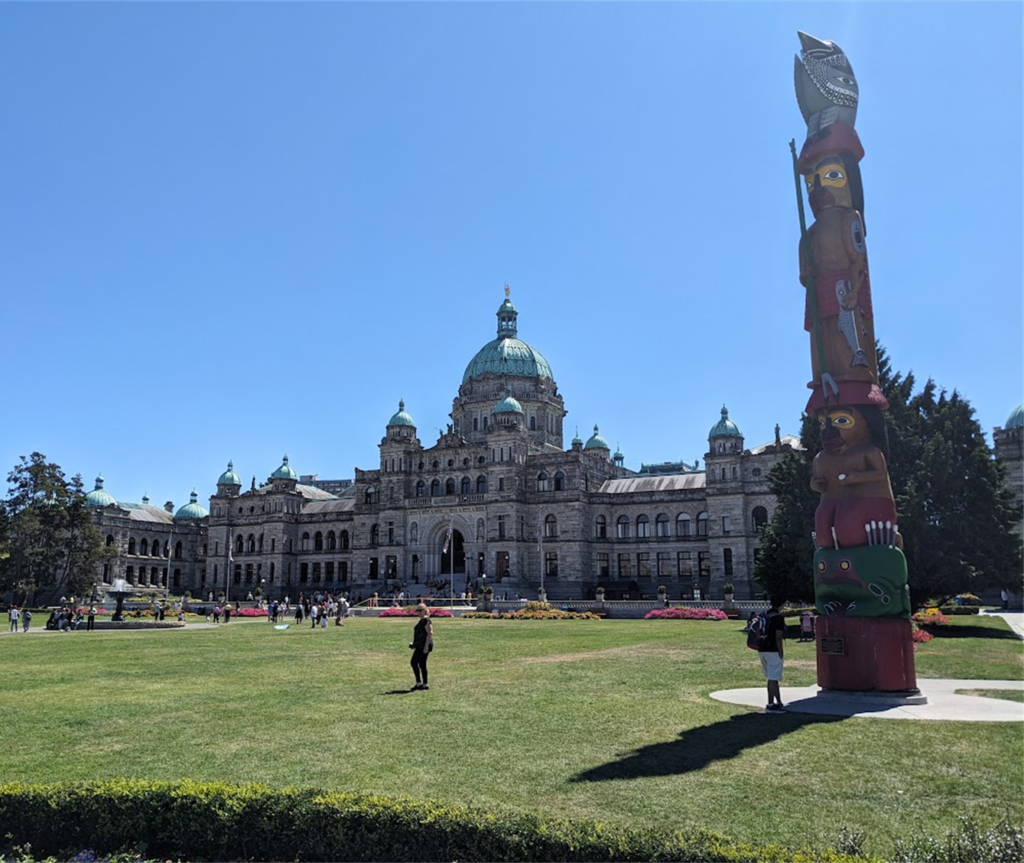I realize I have already told you a lot about our Canadian trip, but while presenting a talk to the Lyceum Club about our trip, I realized how much I had left out, and for my own benefit,at least, will record it here.
When considering a trip to Canada, it is wise to think about the weather. We didn’t.
In 1993, (as I may have mentioned), we drove across Canada with a small baby, a two man tent, and an olive green Chevrolet Caprice we had bought in the USA for $800. It was early spring. Our first campsite beside Niagara Falls was so cold I spent the night worrying that the baby would freeze. As I poked icy fingers down the back of her neck every hour to check she was still alive, I seriously considered moving to the heated bathroom block for the rest of the night.
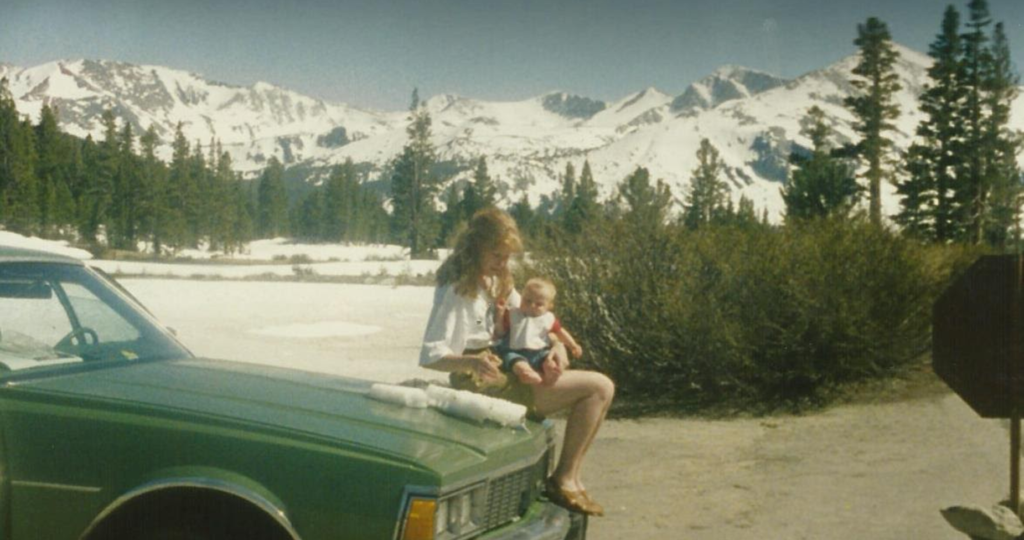
In 2024 we flew to Canada in July – and the heat was oppressive. Everyone said the humidity was unusual, but with the profusion of lakes and rivers in Canada, we probably should have seen that coming! So, the best time to visit Canada? Late Spring to early summer. Or early Autumn… sorry Fall. We’ll take our own advice next time.
Nonetheless, travelling through Canada was a never-to-be-forgotten experience. Both times.
So what were the biggest differences? Most notably, in 1993 we had a small baby. with a lot of parphenalia. This time it was just us and our suitcases. In 1993, we only had a small Kodak camera, and going on the limited number of photos, only one roll of film! This time, we took a squillion photos on our phones. Our first trip was made on the smell of an oily rag, so we were either camping or staying in cheap motels. This time, absent a kind friend or relative to provide a bed, we made good use of Airbnb . Interestingly, this often involved basement accommodation – an ubiquitous part of Canadian housing which we kept saying might have been a sensible addition to housing in South Australia, to escape our hot summers!
Back in 1992, we were living in Ireland and expecting our first child. Having decided we should probably head home to show her off to the family, we planned a three month road trip en route to prove that a baby was not going to change our nomadic ways.
So, the One & Only started writing to every National Park in North America, and for weeks, he had been accumulating hefty piles of brochures and maps with which he carpeted the floor of our tiny cottage. No internet back then!
Initially we had planned to drive across the States. Given the comparative cost of petrol, I’m not sure why we changed our minds, but it was not a decision we regretted. It was going to be a long drive, but I was prepared, too, and had collected a large pile of novels to read aloud to my chauffeur, while the baby – who had slept little for the first weeks of her life – slept like an angel on the back seat. In 2024, we considered a train trip, but decided it would be quicker – and cheaper – to fly. So, thus, we used West Jet to fly between cities, from Toronto to Vancouver. There was less capacity for luggage, but I swear my one suitcase grew heavier at every airport!
In 1993, we drove north from Pennsylvania, where we had bought the car, through New York State to Niagara, where we boarded the Trans Canadian Highway and headed east.
The Trans Canadian Highway claims to be the longest national road in the world, stretching almost 5,000 miles from the North Pacific in the west to the Atlantic coast in the east, passing through every province on the way. (Actually, Highway One around Australia is almost double that, but who’s competing?) In 1993, we drove from Montreal to Kamloops, and this year, we picked up the trail in the Okanagan Valley and made it down to Mile Zero Park on Vancouver Island, but we have yet to make it all the way across to its eastern-most point on Cape Breton Island.
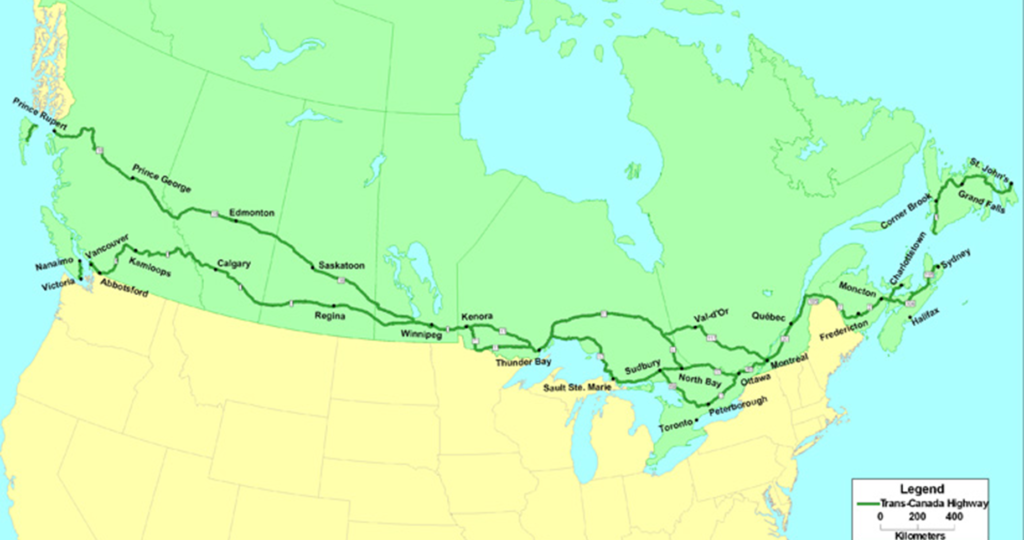
On that first trip, we knew virtually nobody in Canada, apart from my grandmother’s first cousin in Ottowa, a family friend just north of Toronto and a bloke in Montreal. Thanks to their hospitality, we got a bried look at those cities, but with a tent and a baby in tow, we largely kept to country towns. This time, we were able to visit several cities we had missed in 1993, namely Winnipeg, Regina, Vancouver, and Victoria.
Another big difference between Trip One and Trip Two. With a baby that was still waking for a meal every three hours, round the clock, a lot of that first trip passed by in a blur of sleepless nights that felt like chronic fatigue. In Montreal, I can vaguely remember inspecting the Olympic Village from the 1976 Games. In Ottawa, I remember a wonderful story about the businessmen who would ice skate to work in winter, along the frozen canal, briefcase in hand. Just north of Toronto, there was an amazing rocking chair, where I sat up every night, calming our colicky baby. And I think there may have been an ice hockey match…
This time, I got to sleep a lot more, so my memories are clearer! This time we were able to catch more than a glimpse of Toronto, as we went down to the city for a couple of days, to visit a cousin. This meant the chance to see the fascinating extension to The Royal Ontario Museum. First opened in 1914, the ROM is a museum of art, world culture and natural history, and has been regularly expanded and reorganized over the past century. In 2007, the Michael Lee-Chin Crystal was opened, although sadly, when we were there, it was wrapped in scaffolding for renovations. Instead, we had a long and beautiful walk through all the green park lands surrounding the university and parliament buildings.
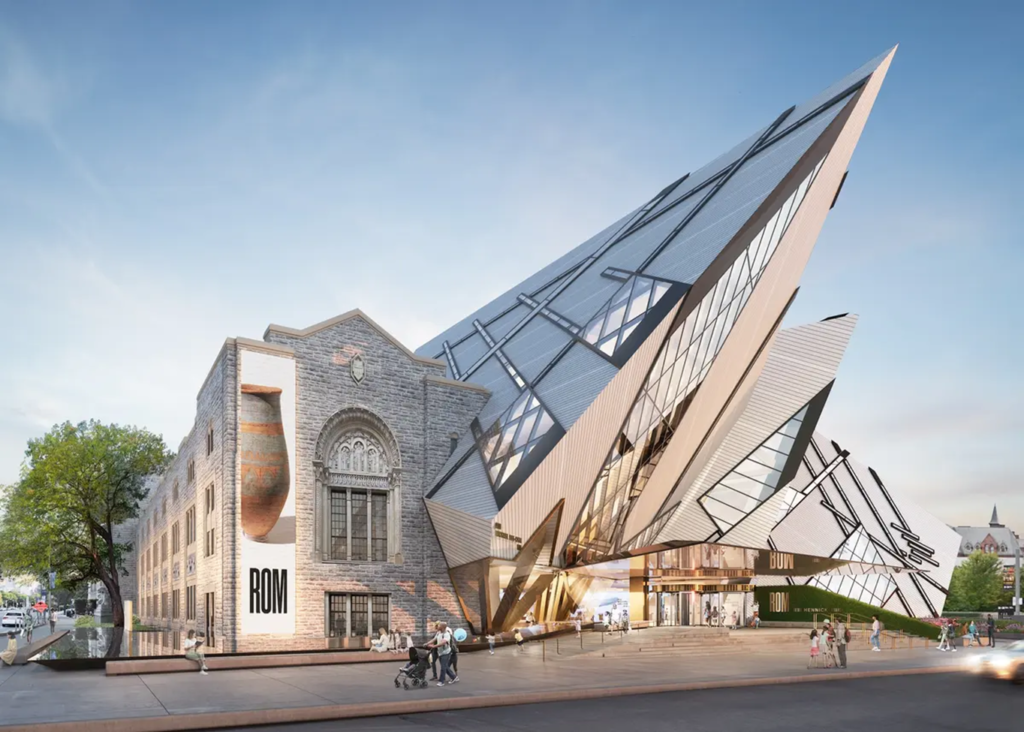
My cousin lives in a pretty area to the east of the city. Church and Wellesley is known affectionately as “The Village” which has become the heart of Toronto’s gay community.
In Canada, homosexuality was punishable by death until 1869, and gay men were branded as “criminal sexual psychopaths” until the 1960s, and once upon a time, not so long ago, homophobes would frequently attack known homosexual businesses, But by early 1980s there were many openly gay bars, clubs, and businesses in this pretty area of Toronto, and even an annual drag queen contest. Today, it is a cool and friendly environment where people can live, work and play safely, whatever their sexual orientation. And my cousin, although not gay himself, is more than happy to give the queer community all the credit for gentrifying the area and restoring its beautiful old houses that had become horribly rundown. This, and its historic significance as one of the oldest surviving corners of Toronto, has fortunately kept the neighbourhood largely free of all the modern high rise apartments that have swamped the rest of the city.
Back to 1993, we left the outskirts of Toronto to head north west, following the edge of Lake Huron and Lake Superior to Thunder Bay. Where there was snow. In late April. So we stayed in a lovely B&B. From Thunder Bay we drove on through Manitoba, Saskatchewan and Alberta, barely pausing for breath, the flatline that was the horizon broken only by the occasional silo beside the railway track. My Ottowa cousin had provided the name of another cousin in Portage, where we paused for two or three nights and learned a lot about canola, a relatively new crop on the Canadian prairies. It certainly added vivid splashes of yellow to the landscape, when we flew across the prairies thirty years later…
… to land in Winnipeg, where we had organized to meet a handful of ‘new’ cousins. Winnipeg is flat as a pancake, and threaded with rivers, which has led to terrible flooding in the past. Fortunately, flooding has largely been averted since the government spent millions to build a giant floodway around the eastern edge of the city. And while the outlying prairies were as flat and lacking in trees as the Nullarbor, the inner city suburbs were full of pretty weatherboard houses and tree-lined streets, especially around the French quarter of St Boniface, on the eastern bank of the Red River, or Riviere-Rouge. Across the river, at the confluence of the Red and Assiniboine rivers, and an area known as The Forks, for obvious reasons. This has been a meeting place for indigenous hunters for over 6,000 years and was similarly used by the European fur traders in the eighteenth and nineteenth centuries. In the 180s, it became the site of the railway yards of the Canadian railroad companies and the immigration sheds for new migrants.
Over the last 30 years, the abandoned railway yards have been transformed into museums and accommodation, food and retail outlets, playgrounds and parks. The Forks Market – once horse stables and haylofts – now contains a Food Hall with two dozen restaurants and cafes, where you can find anything from Filipino to Caribbean cuisine, Sri Lankan to Greek, and various bakeries and coffee shops. There is a River Walk, through parks full of ground squirrels racing about and burrowing beneath the lawn. And just beyond this playground for rodents, stands the Canadian Museum for Human Rights, which came highly recommended by all the Winnipeg cousins.

Portage la Prairie is about an hour’s drive west of Winnipeg. Since our last trip, and now on a concentrated search for family history, I had learned that this is where my extended family had first settled in 1903. So, we drove out one day to search the cemeteries for my ancestors and to knock on the door of the farmhouse that was built by my great great aunt and her husband, when they first arrived in Manitoba.
Then it was up, up and away in a small prop plane heading for Regina, which we had by-passed in 1993, en route to Jasper. Then, we drove north west, past the record breaking shopping mall in Edmonton, that covers 49 hectares – the equivalent of 104 football fields – and which has become not only the prime shopping area for locals, but a significant tourist attraction. Given the long, severe winters in Canada’s most northern city, where better to build such an extravaganza?
By the time we reached the Rockies, the season was warming up at last, and we were finally able to resurrect the tent. Our first camping site in Jasper National Park was closed for most of this past summer, due to extreme bushfires. In 1993, I was a little nervous about camping here. Not because of fires, but because there had been so much talk of bears. And moose. In fact, the campsite was awash with moose pairing up to make baby mooses. How would we escape a hungry bear with a baby strapped to our chest? Or get out of the way of those enormous antlers, angry to be coitus interruptus by unwary walkers? Luckily, the moose preferred their own company to ours, and the bears were presumably still hibernating. So, we saw nothing more threatening than the dams and detritus from the logging efforts of a colony of busy beavers.
We drove on unmolested, heading south down the Icefields Parkway past Lake Louise – as pretty as the pictures – to Banff, passing several glaciers en route. We stopped half way to clamber up the Athabasca glacier – the largest and most accessible of the glaciers in Glacier National Park – with one small bean snuggled inside her papoose.
From Banff we turned west again to the Okanagan Valley, where pink and white blossom was in full bloom. This lake-filled valley was first settled by Europeans in the early 19th century, and was quickly recognized as a great place to plant fruit trees. The 180km-long Okanagan Valley is now home to orchards of peaches and apricots, apples and pears, nectarines and cherries and – more recently – scores of wineries. Unfortunately, this year, a late cold snap resulted in the loss of their annual peach crop. The frost also affected the grapevines, and many farmers were preparing to start over with new, hardier trees and vines.
Since our last visit, thirty-odd years ago, the suburban sprawl has expanded exponentially, roads and bridges have been widened and the rural areas have been planted with acres of grape vines, an industry that was only just starting up in 1993. Now Okanagan wines are sold across the country. Tourism has become a major industry in Kewlona, too, both in summer, for sailing and golf, and in winter, for skiing and snowboarding. Despite the pall of smoke from a huge bushfire to the north, we spent a lovely afternoon swimming at a sandy, lakeside beach near the aptly named Summerland, and a wonderful evening dining at the Sailing club in Kelowna, overlooking the water and hundreds of boats. On our last night, a fresh wind finally blew the curtain of smoke aside, and we could see the stars – and the eagles – as we sipped a local wine on a balcony above the lake.
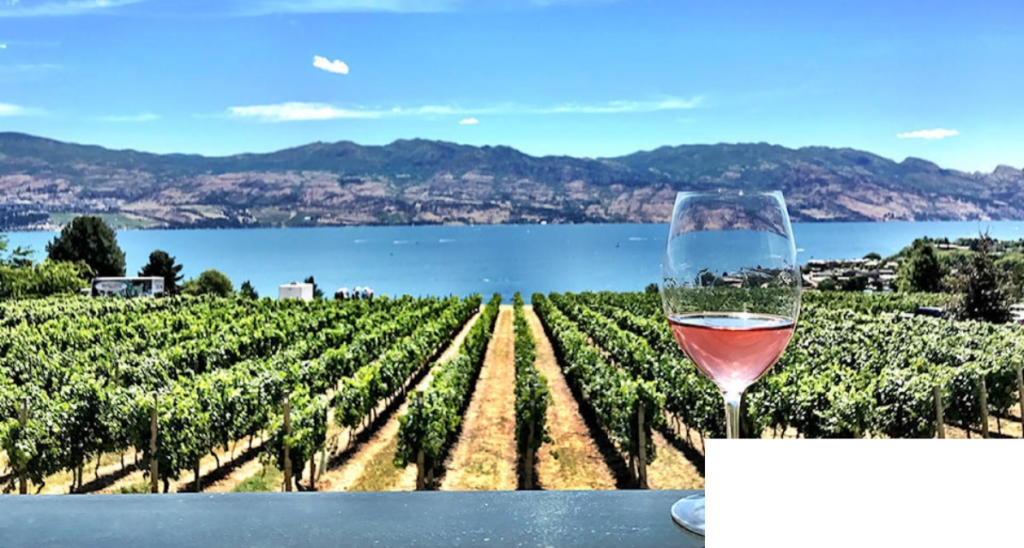
We never made it to Vancouver in 1993 but headed south from Kelowna and crossed into Washington State. This summer, we had a few days to explore this last Canadian city before reaching the Pacific. We spent a wonderful day on the water, exploring False Creek, named by surveyor George Henry Richards, because the creek proved to be a dead end. Having bought a day pass for False Creek Ferries, we boarded a pocket sized boat beside the Maritime Museum. The ride gave us some spectacular views of this surprisingly high-rise city. By fluke, we exchanged the little ferry for a beautiful launch on the way back, and a young captain eager to tell us all he could about his wonderful city.
From Vancouver, we took another boat trip, this time on a large ferry across the Salish Sea to Vancouver Island. This is a beautiful trip that weaves through the Gulf islands and made me long to have another month and a sailing boat up our sleeves.
456 km long and 100 km across at its widest point, Vancouver Island lies off the south coast of British Columbia, and is home to Victoria, the elegant capital city of British Columbia. Around half the population of the island live in Victoria, but with only 45,000 inhabitants, it has the easy-going calm of a large country town, despite the daily influx of tourists from mainland Canada and Washington State.
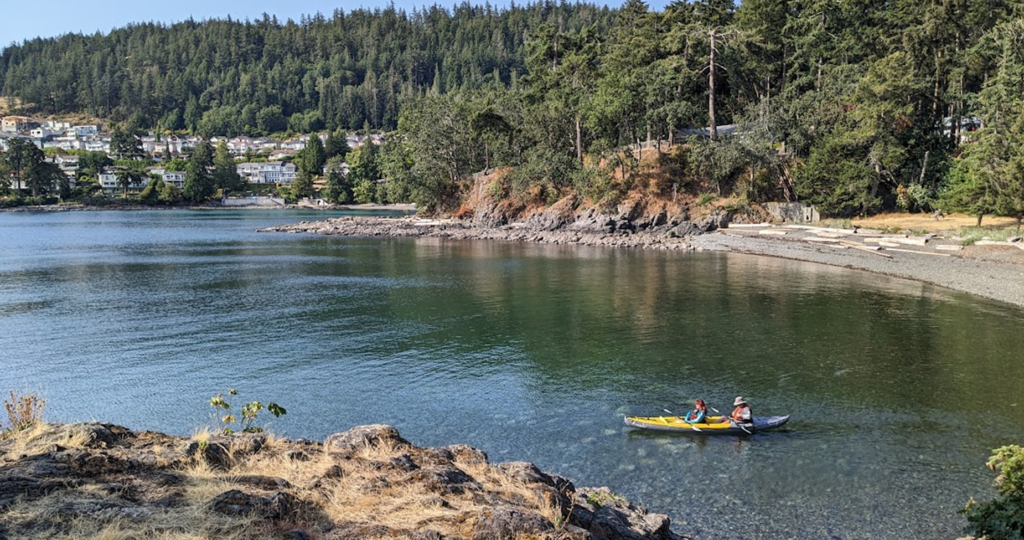
Our first stop was Nanaimo on the east coast of Vancouver Island. When the Europeans first arrived here, the major industry was coal mining. By the 1960s, this had been supplanted by forestry. Today, the largest employer is the provincial government, with retail, hospitality and tourism not far behind.
We spent one sunny morning strolling along Nanaimo’s Harbourfront Walkway to the Bastion – an octagonal wooden tower built in 1853, to defend the Hudson Bay Company’s coal mining operations. Just down the road, we stopped for coffee and tried the incredibly sweet eponymous Nanaimo Bar. The Nanaimo bar requires no baking, and consists of three layers: a wafer, nut, and coconut crumb base; custard icing in the middle; and a layer of chocolate ganache on top. It was way too sweet for me, and even the One & Only, who doesn’t mind the odd sugar fix, could only eat half!
A few days later, we moved down the island to Victoria for our last days in Canada. On Fisherman’s Wharf, we considered living on one of the pretty floating homes, and decided the volume of tourists peering through the windows would probably put us off. Wandering back across town, we strolled across the lawns in front of the handsome Legislative Building, that was opened in 1898. In front of it stands the Knowledge Totem Pole. This was carved by Cicero August, an indigenous sculptor from the island, and raised on February 2, 1990. The pole refers to the oral traditions of the Indigenous peoples of the northwest coast. The top figure, the loon, represents “the teacher of the speakers” as well as an interpreter of all the Indigenous languages spoken. The fisherman represents the traditional way of life of coastal Indigenous peoples. Below the fisherman is the bone player, who represents a non-verbal game that can be played by people who do not share the same language. The bottom figure, the frog, is a symbol of stabilty and is also used used on Haida house posts for that purpose. Frogs also represent wealth, abundance, ancient wisdom, rebirth, and good luck.
I was sad to leave this welcoming, wonderful country. but luckily there are plenty of good reasons for going back. Not least to do that last stretch of the Trans Canadian Highway to the Atlantic Coast, to visit Anne of Green Gables territory on Prince Edward Island!
*With thanks to the One & Only for allowing me to use a few of his squillions of photos – and for finding a couple of the old ones rom our original trip! The oneof the ROM is an artist’s impression from the internet, as it didnt look this good wrapped in plastic!


